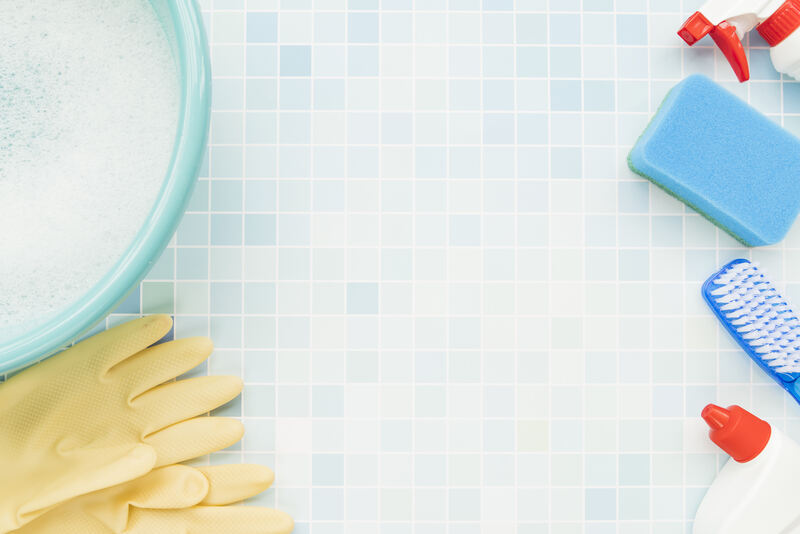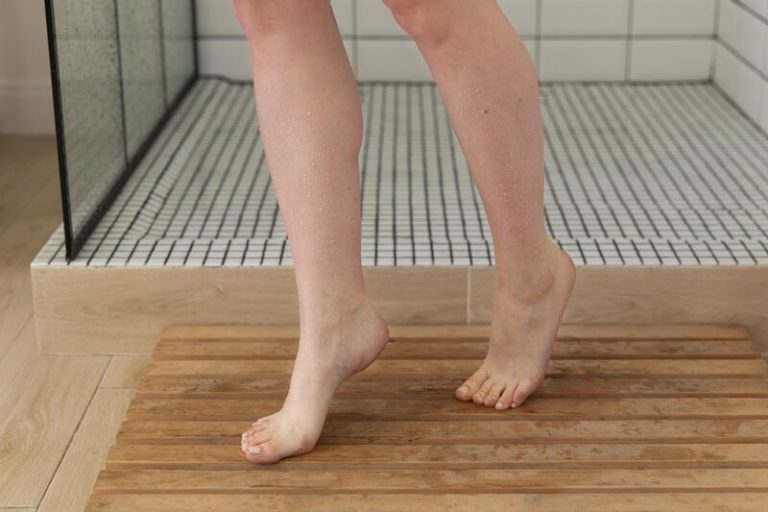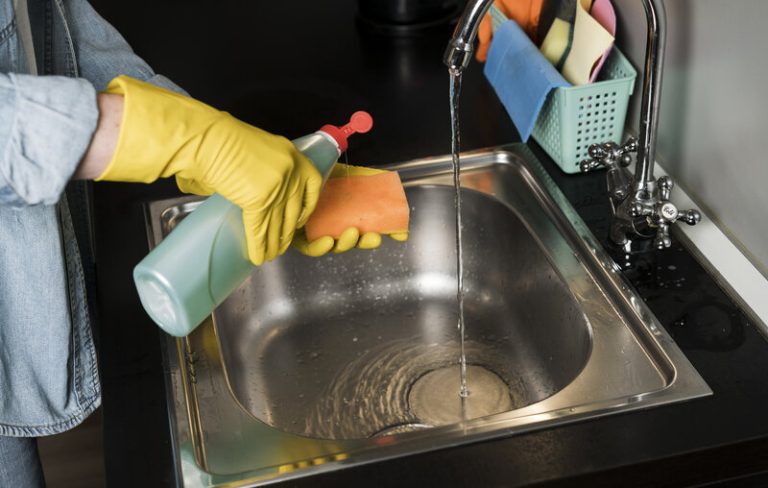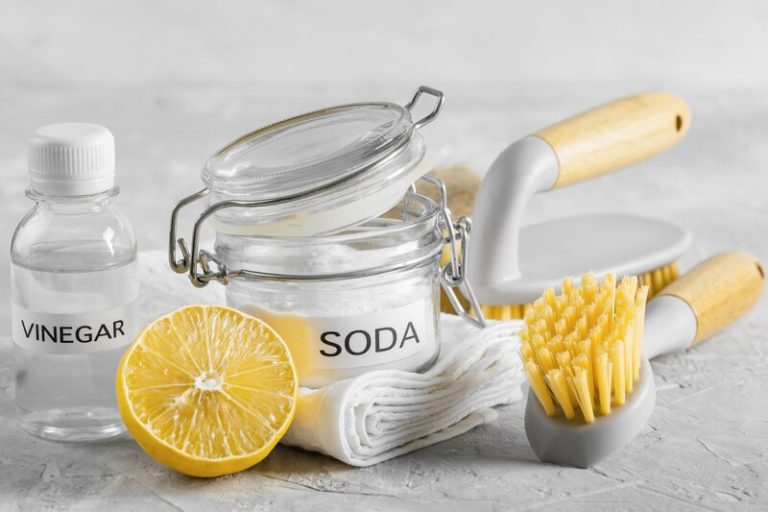Are you tired of looking at dirty and grimy bathroom tiles? Then, it’s high time to know how to clean bathroom tiles.
Although it seems simple, cleaning dirty bathroom floor tiles is very important to maintain a hygienic environment and keep your bathroom looking fresh and attractive.
In this article, we will cover how to clean bathroom floor and wall tiles. Moreover, we will also share some tips for cleaning bathroom floor tiles. Let’s get started!
The Importance of Cleaning Bathroom Tiles
Maintaining clean bathroom tiles is crucial for hygiene and aesthetics. Dirty tiles can harbour germs, mould, and mildew, leading to health concerns and unpleasant odours. Regular cleaning also helps preserve the tiles’ appearance and longevity, preventing the build-up of grime and stains.
Hygiene is of utmost importance in bathroom maintenance as it directly impacts the health of inhabitants. Clean tiles reduce the risk of bacteria and viruses thriving in the damp environment, promoting a healthier living space. A well-kept bathroom enhances the overall aesthetic appeal of the home, creating a welcoming atmosphere for residents and guests alike.
What to Clean Bathroom Tile Floor With?
To effectively clean bathroom tiles, you will need specific tools and supplies. These include a scrub brush, grout brush, white vinegar, bicarbonate of soda, hydrogen peroxide, washing-up liquid, and a bucket of water. Each of these items plays a crucial role in ensuring thorough and efficient tile cleaning. The details of each are as follows:
a. Scrub Brush
A scrub brush is a vital tool for cleaning bathroom tiles, especially for removing stubborn dirt, grime, and soap scum. It helps to scrub the tiles effectively without damaging their surface, ensuring a thorough cleaning process.
Using a scrub brush offers a hands-on approach to maintaining cleanliness in your bathroom. The bristles of the brush reach deep into the grout lines, ensuring that every nook and cranny is free from build-up.
Regular use of a scrub brush not only keeps your tiles looking new but also prolongs their lifespan by preventing permanent stains and discolouration that can occur due to neglect.
b. Grout Brush
A grout brush is essential for cleaning the grout lines between tiles, where dirt and mould tend to accumulate. It helps to remove debris and stains from the grout, restoring its original colour and cleanliness.
Regular use of a grout brush prevents the build-up of grime, which can lead to discolouration and unsightly patches in your bathroom or kitchen tiles. With its sturdy bristles, the grout brush can reach into the narrowest spaces, ensuring a thorough clean.
Proper maintenance of grout lines not only enhances the aesthetics of your tiled surfaces but also extends the lifespan of your tiles by preventing moisture and mould formation.
c. White Vinegar
White vinegar is a natural and effective cleaning solution for bathroom tiles due to its acidic properties. It helps dissolve mineral deposits, soap scum, and hard water stains, leaving the tiles clean and shiny.
White vinegar is a versatile cleaner that not only sanitises but also deodorises, eliminating unpleasant odours in the bathroom. Its antibacterial properties make it an ideal choice for maintaining hygiene in this high-moisture area, preventing the growth of mould and mildew.
Using white vinegar as a cleaning solution is budget-friendly and environmentally friendly, reducing the need for harsh chemical cleaners that can be harmful to both health and the environment. By incorporating white vinegar into your cleaning routine, you can enjoy sparkling clean bathroom tiles with minimal effort.
d. Baking Soda
Bicarbonate of soda is a versatile ingredient that can be used to clean bathroom tiles effectively. When combined with water or vinegar, bicarbonate of soda not only unclogs drains but also effectively removes soap scum, mildew, and hard water stains.
Its gentle yet abrasive nature makes it ideal for tackling tough stains on ceramic tiles without causing damage. The deodorising properties of bicarbonate of soda help eliminate odours, leaving your bathroom smelling fresh and clean.
Whether you’re cleaning tile floors, shower walls, or countertops, bicarbonate of soda proves to be a versatile and eco-friendly solution for maintaining the cleanliness and shine of your bathroom surfaces.
e. Hydrogen Peroxide
Hydrogen peroxide is a powerful disinfectant and stain remover that can be used to clean bathroom tiles effectively. It helps kill germs, mould, and mildew, while also whitening grout and removing tough stains.
Additionally, hydrogen peroxide is an environmentally friendly option compared to many harsh chemical cleaners. Its bubbling action helps to lift dirt and grime from tile surfaces, making it easier to wipe away. It is relatively inexpensive and readily available in most stores, making it a convenient choice for regular maintenance of bathroom tiles. By regularly using hydrogen peroxide as a cleaning agent, you can prevent the build-up of bacteria and keep your tiles looking fresh and clean.
f. Dish Soap
Washing-up liquid is an effective and gentle cleaner for bathroom tiles, especially when mixed with water. It helps break down grease, grime, and soap scum, making it easier to clean and maintain the tiles on a regular basis.
Using washing-up liquid as a cleaning agent for bathroom tiles not only effectively removes stubborn stains but also ensures a streak-free finish. The mild nature of washing-up liquid makes it safe for most tile surfaces, preventing any damage that harsh chemicals might cause. When combined with microfibre cloths, washing-up liquid creates a dynamic cleaning duo that easily lifts dirt without scratching the tiles. Regularly incorporating washing-up liquid into your tile cleaning routine can help preserve the tiles’ appearance and extend their lifespan.
g. Bucket of Water
A bucket of water is essential for rinsing and mopping the bathroom tiles during the cleaning process. It helps remove cleaning residue, dirt, and soap scum, ensuring a thorough and final rinse for sparkling clean tiles.
The presence of a bucket of water serves as a versatile tool for maintaining cleanliness throughout your tiled spaces. Not only does it aid in the initial rinsing and mopping off of cleaning agents, but it also offers a quick solution for any unforeseen spills or stains that may occur during the cleaning process.
How to Clean Bathroom Wall Tiles?
Cleaning bathroom wall tiles requires a methodical approach to ensure a thorough and sparkling finish. Let’s take a look at the step-by-step explanation below:
a. Preparing the Solution
Before cleaning bathroom wall tiles, it is essential to prepare a suitable cleaning solution. You can mix white vinegar, baking soda, or hydrogen peroxide with water to create an effective cleaning solution that targets dirt, grime, and stains on the tiles.
White vinegar is a versatile natural cleaner that helps dissolve grime and soap scum, making it ideal for cleaning bathroom tiles. Alternatively, baking soda acts as a gentle abrasive that can scrub away tough stains without damaging the grout or tiles.
Hydrogen peroxide is a powerful disinfectant that not only cleans but also sanitizes the surfaces, leaving your bathroom tiles sparkling and germ-free.
b. Cleaning the Tiles
When cleaning bathroom wall tiles, use a gentle scrubbing motion to avoid damaging the tile surface. Focus on removing dirt, soap scum, and mildew from the tiles, paying special attention to the grout lines where dirt tends to accumulate.
One effective method for cleaning grout in between tiles is to use a mixture of bicarbonate soda and vinegar. Apply the paste to the grout lines and let it sit for a few minutes before scrubbing gently with a soft brush. This natural solution helps to break down grime and stains without harsh chemicals.
c. Cleaning the Grout
Cleaning the grout lines between bathroom wall tiles is essential for a complete tile cleaning process. Use a grout brush or a mixture of bicarbonate of soda and water to scrub the grout lines and remove any embedded dirt or stains, restoring their original colour.
Dirty grout not only looks unsightly but also can harbour germs and mould, affecting the overall cleanliness and hygiene of your bathroom. By maintaining clean grout lines, you can prevent discolouration and deterioration of the tile joints, ensuring a longer lifespan for your tiles.
To achieve a deep clean, consider using a steam cleaner or a commercial grout cleaner that can penetrate and lift stubborn grime effectively. It’s also advisable to seal the grout after cleaning to prevent future staining and make maintenance easier in the long run.
How to Clean Bathroom Floor Tiles?
As mentioned earlier, understanding how to clean bathroom tiles is very important to maintain a clean and hygienic environment in your bathroom. Here is a further explanation of the best way to clean bathroom floor tiles that you can follow:
a. Sweeping and Mopping
Start the process of cleaning bathroom floor tiles by sweeping away dust, hair, and debris from the surface. Follow up with mopping using a mild cleaning solution to remove any remaining dirt and grime, ensuring a clean and dust-free tile surface.
It is crucial to begin the cleaning regime with sweeping as it helps eliminate loose particles that can scratch the tiles during mopping. The gentle sweeping motion not only clears visible debris but also preps the tiles for a thorough mopping session.
A mild cleaning solution is recommended during mopping, as harsh chemicals can damage the tile’s finish over time. By using delicate cleaning methods like these, you can maintain the longevity and appearance of your bathroom floor tiles with ease.
b. Applying the Cleaning Solution
After sweeping and mopping the bathroom floor tiles, apply a suitable cleaning solution to break down dirt and grime. Allow the solution to sit for a few minutes to penetrate tough stains before proceeding with the scrubbing process for thorough tile cleaning.
Effective tile cleaning is essential for ensuring a hygienic and visually appealing bathroom space. By applying a designated cleaner, you can target specific stains and grime, making the overall cleaning process more efficient.
The waiting time after application is crucial as it allows the solution to work its magic, loosening stubborn dirt for easier removal. Once the solution has had time to penetrate, using a scrub brush or sponge in circular motions can effectively lift off the loosened dirt particles, leaving your tiles sparkling clean.
c. Scrubbing and Rinsing
To deep clean bathroom floor tiles, use a scrub brush or sponge to scrub away dirt and stains. Rinse the tiles thoroughly with clean water to remove any cleaning residue and soap scum, ensuring a clean and fresh finish for your bathroom floor.
After scrubbing the tiles, it’s crucial to pay attention to the rinsing process. Make sure to use enough water to completely wash away any remaining dirt or cleaning solution.
Thorough rinsing is essential in preventing soap buildup and maintaining the lustre of your tiles. Consider using a squeegee to remove excess water efficiently, leaving your tiles streak-free and sparkling. Allow the floor to air dry or use a soft cloth to gently pat it dry for a flawless shine. Proper maintenance and regular cleaning will keep your bathroom tiles looking their best!
Tips for Maintaining Clean Bathroom Tiles
Instead of understanding how to clean bathroom tiles, you should also understand how to keep your bathroom tiles clean. These include using a mild cleaning solution, avoiding abrasive cleaners, wiping tiles dry after cleaning, and addressing stains promptly to prevent permanent discolouration.
Another effective way to prevent stains on bathroom tiles is to use a grout sealant periodically. This will create a protective layer that repels water and stains, making it easier to clean the tiles in the long run. Incorporating a weekly routine of wiping down the tiles with a mixture of water and vinegar can help prevent grime buildup and keep the tiles looking fresh.
When dealing with stubborn stains, creating a paste of baking soda and water and applying it to the affected areas can work wonders. Let it sit for a few hours before scrubbing gently with a soft brush to lift the stains without damaging the tiles. This gentle abrasive action is effective in removing tough stains without causing harm.
That concludes the explanation about the best method to clean bathroom floor tiles that you can understand. Now, you know how to clean bathroom tiles, right?
However, for a truly thorough clean and to save yourself time and effort, consider using TEKA Cleaning’s residential cleaning services. Our professional team will ensure your bathroom tiles and entire home are sparkling clean.
Contact us today to book our residential cleaning services. Call 01233 751 544 and let TEKA Cleaning transform your home into a spotless haven.
Read also:











